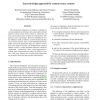Free Online Productivity Tools
i2Speak
i2Symbol
i2OCR
iTex2Img
iWeb2Print
iWeb2Shot
i2Type
iPdf2Split
iPdf2Merge
i2Bopomofo
i2Arabic
i2Style
i2Image
i2PDF
iLatex2Rtf
Sci2ools
VAMOS
2007
Springer
2007
Springer
Layered design approach for context-aware systems
The omnipresent integration of computer technology in everyday applications introduces new opportunities to make software systems aware of the context in which they are used. Such context-aware systems can respond more adequately to user expectations. However, modelling the context influence inside of software systems burdens developers for several reasons. First, context-dependent behaviour might crosscut the application logic of a software system. Next, since software systems can simultaneously reside in multiple contexts, context-dependent behaviour should be composable. Furthermore, since context information is volatile, these compositions are subject to change at runtime. This paper explores how layered design approaches can be used to deal with these specific characteristics.
| Added | 09 Jun 2010 |
| Updated | 09 Jun 2010 |
| Type | Conference |
| Year | 2007 |
| Where | VAMOS |
| Authors | Brecht Desmet, Jorge Vallejos, Pascal Costanza, Robert Hirschfeld |
Comments (0)

